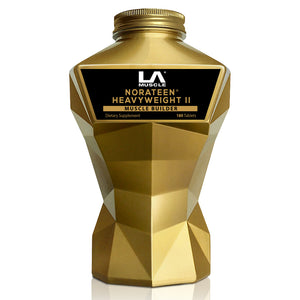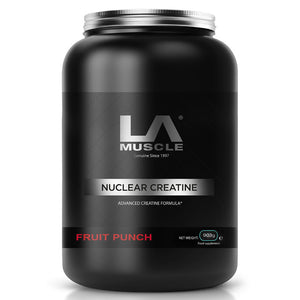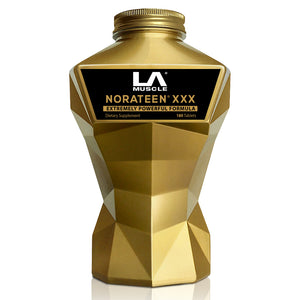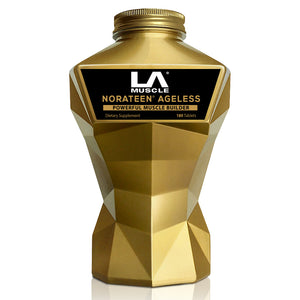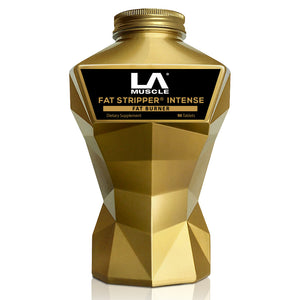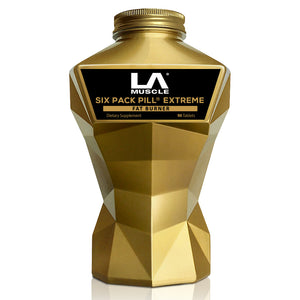D-Aspartic acid (D-AA) has garnered attention in sports and health sciences due to its potential impacts on testosterone, muscle strength, and body composition. This article delves into the physiological role of D-AA, its mechanisms in testosterone enhancement, and its implications for muscle development, particularly highlighting its incorporation in LA Muscle's Norateen Heavyweight II, a supplement which is Pharma Grade (not just food grade)y. A critical review of scientific literature and clinical studies is conducted to discern the veracity of these claims and understand D-AA's effectiveness and safety profile.
-
Introduction: D-Aspartic acid (D-AA), an endogenous amino acid, is present in neuroendocrine tissues of humans and other animals, notably influencing the release of hormones in the body, including testosterone (D'Aniello, 2007). Its role in steroidogenesis and subsequent effects on strength and muscle development make D-AA a popular supplement among athletes and bodybuilders, a key ingredient in products like LA Muscle's Norateen Heavyweight II.
-
D-Aspartic Acid and Testosterone Synthesis: The Biological Mechanism D-AA operates within the brain's hypothalamus and the pituitary gland to stimulate the secretion of signaling hormones, leading to the testes producing testosterone (Topo et al., 2009). It enhances the release of gonadotropin-releasing hormone (GnRH), luteinizing hormone (LH), and (GH) from the pituitary gland, all crucial regulators of testosterone synthesis. Additionally, D-AA serves as a physiological messenger in the central role of testicular steroidogenesis (D'Aniello, 2007).
-
Scientific Evidence: Human and Animal Studies The testosterone-boosting claims of D-AA garnered scientific interest, leading to several studies. One such research on men with impaired sperm production showed a significant increase in testosterone levels following D-AA supplementation (D'Aniello et al., 2012).
-
D-Aspartic Acid in Muscle Synthesis and Strength Building The role of testosterone in muscle protein synthesis and adaptive growth is well-documented (Urban & Veldhuis, 2018). By hypothetically increasing testosterone, D-AA may contribute to muscle hypertrophy and strength.
-
D-Aspartic Acid in LA Muscle's Norateen Heavyweight II LA Muscle's Norateen Heavyweight II combines D-AA with other ingredients, giving synergistic effects for muscle growth and strength. However, these claims require rigorous clinical trials for validation.
-
Safety Profile and Considerations D-AA is generally considered safe in recommended doses, with no effects reported, when used as directed. Individuals with medical conditions or on medication should consult healthcare professionals before supplementation.
-
Conclusion: D-Aspartic acid plays a crucial physiological role in hormone regulation and has potential implications for enhancing testosterone and, by extension, muscle strength and size. Products like LA Muscle's Norateen Heavyweight II capitalise on D-AA's potential benefits and use other ingredients to further boost muscle and strength.
References:
- D'Aniello, A. (2007). D-Aspartic acid: an endogenous amino acid with an important neuroendocrine role. Brain research reviews, 53(2), 215-234.
- Topo, E., Soricelli, A., D'Aniello, A., Ronsini, S., & D'Aniello, G. (2009). The role and molecular mechanism of D-aspartic acid in the release and synthesis of LH and testosterone in humans and rats. Reproductive Biology and Endocrinology, 7(1), 120.
- D'Aniello, G., Ronsini, S., Notari, T., Grieco, N., Infante, V., D'Angelo, N., ... & Fisher, G. (2012). D-Aspartate, a Key Element for the Improvement of Sperm Quality. Advances in Sexual Medicine, 2(4), 45-53.
- Melville, G. W., Siegler, J. C., & Marshall, P. W. (2015). The effects of d-aspartic acid supplementation in resistance-trained men over a three month training period: A randomised controlled trial. PloS one, 10(8), e0137423.
- Urban, R. J., & Veldhuis, J. D. (2018). Testosterone and muscle protein metabolism. Mayo Clinic Proceedings, 93(12), 1844-1854.
- Roshanzamir, F., & Safavi, S. M. (2017). The putative effects of D-Aspartic acid on blood testosterone levels: A systematic review. International journal of reproductive biomedicine, 15(1), 1–10.



